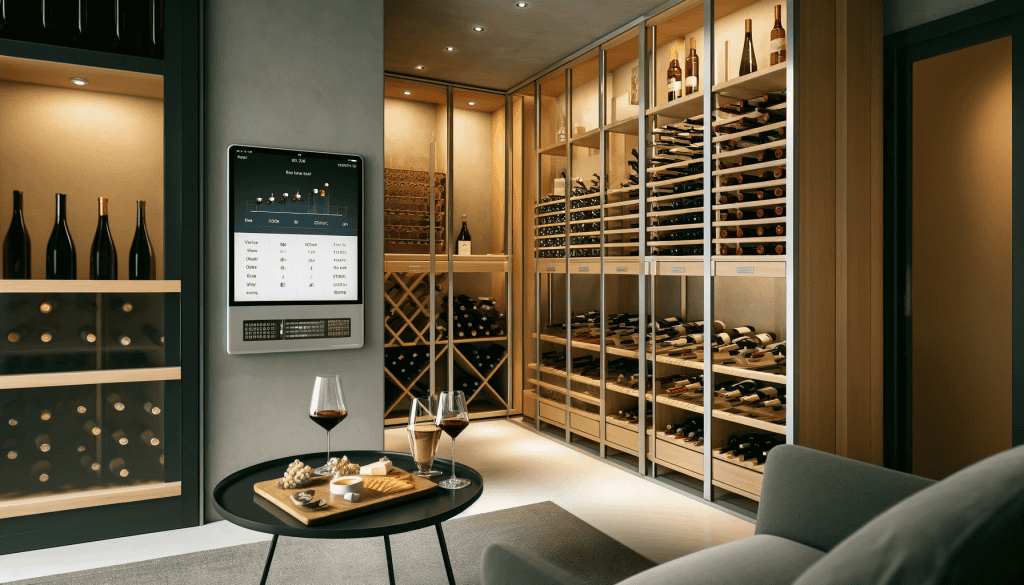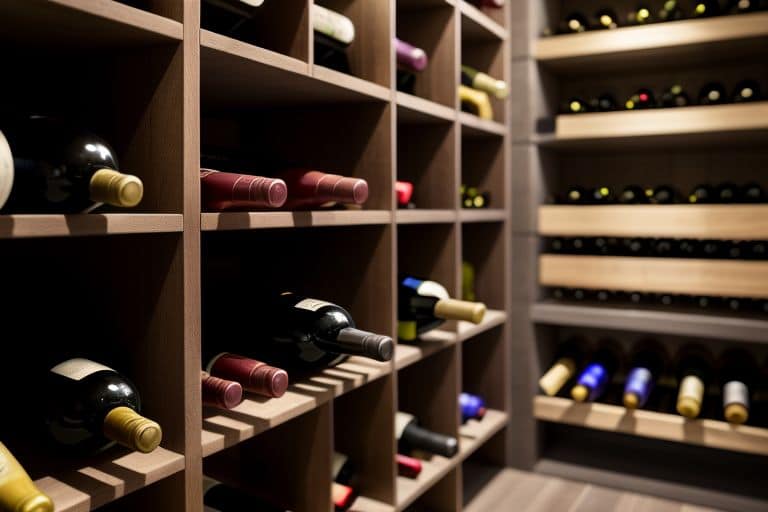Passions grow over time, and so do collections of any kind. With the growing number of wine bottles, the desire and necessity to keep an overview is growing, too. Here’s how to organize your wine cellar in a simple but effective way.
Welcome to Didi Somm, and let’s find out “how to organize a wine cellar”!
Important Notice: The information in this article is for general and public information purposes only. It solely reflects Didi Somm’s or his Staff’s opinion, and no responsibility can be assumed for errors or omissions in the service’s contents. For details, please check the Disclaimer at the bottom of the homepage.

Key Takeaways
- Start organizing your collection systematically once it exceeds 50 bottles to preserve quality, save time, and enhance value
- Maintain optimal storage conditions: 55°F (13°C) temperature and 50-70% humidity, with horizontal bottle storage
- Use digital apps (CellarTracker, Vivino) or spreadsheets to catalog wine details like name, producer, vintage, and expiry
- Sort wines by varietal, region, or vintage and categorize as “ready to drink,” “aging,” or “special occasions”
- Regular maintenance includes gentle handling, keeping the cellar clean, and monitoring expiration dates
The Benefits of a Well-Organized Wine Collection:
In our opinion, the level of organization depends on the size of your collection/wine cellar and its number of varieties. To prove the importance of this task, let’s briefly summarize below the main benefits:

When to Start “organizing” Your Wine Collection?
Even a modest wine collection can benefit from a simple organizational system. Beyond 50 bottles, more sophisticated organization techniques, such as inventory management software or specialized storage solutions, become increasingly important to maintain the quality and value of your wines.
Organizational Steps include:
1. Sorting by Varietal, Region, or Vintage – “basic organization”
The essential step to organizing your wine collection is sorting into varietals, regions, or vintages to group similar types of wines together. This method also allows you to track your inventory more efficiently.
2. Cataloging- & Labeling System – “detailed organization”
Catalog your wine collection by creating a spreadsheet or using specialized wine cellar management software. Record details such as wine name, wine producer/winery, region, varietal, vintage, quantity, expiry date, and location within the wine cellar.
Categorize and label the bottles using adhesive wine labels or wine tags attached to the neck or body of the bottle. Include essential information such as the wine name, vintage, and any special notes. Make sure the labels are easily readable and will not damage the bottles.
Sort your wines into categories such as “ready to drink,” “aging,” or “special occasions.”

3. Wine Inventory App – “for sophistication”
Several wine cellar management apps are available, each offering different features and functionality. Some popular options include CellarTracker, Vivino, and Wine Spectator’s WineRatings+.

Our Recommendation: Using a Wine Inventory App can be very helpful in organizing your wine collection since it offers all kinds of features like a Bar Code/QR Code Scanner, Tasting Notes, Food Pairing Info, Social Media links, etc. – check their specific features and reviews and find out if they satisfy your needs.
As an alternative, if you have a relatively stable and smaller collection, an Excel Spreadsheet with the information necessary for you would do the job, too.
4. Consider various Shelving Options
Opt for adjustable shelves to accommodate bottles of different sizes and shapes. This flexibility allows you to maximize storage space and organize your wine cellar more effectively. Labeling your wine shelves and racks with relevant information will help you quickly locate your favorite bottle.


5. Keep Track of the Wines Expiry Dates
Check the expiration dates of your wines regularly and organize them accordingly. Place bottles that need to be consumed sooner at the front of the wine cellar to ensure they are enjoyed before their peak.
6. Maintain Consistent Temperature
Ensure that the temperature in the wine cellar remains stable to prevent fluctuations that could cause thermal shock to the wine bottles. Rapid changes in temperature can damage the wines and compromise their quality. Maintain a consistent temperature between 45-65°F (7-18°C), with 55°F (13°C) being optimal for most wines
7. Maintain Proper Humidity Levels
Monitor the humidity levels inside your wine cellar to prevent corks from drying out and allowing air to seep into the bottles. Invest in a hygrometer to ensure that humidity remains within the optimal range of 50-70%.
8. Store Wine Bottles Horizontally
Store your wine bottles horizontally to keep the corks moist and prevent oxidation. This position also helps distribute sediment evenly, ensuring a smoother pour when the wine is decanted.
For Your Reference
Some of the above points are part of the general wine storage guidelines. For more detailed information, we refer to our recent publications: “The Art of Wine Storage: 30 Best Tips to Preserve Your Wines” and “How to Choose a Wine Cabinet? – 7 Essential Questions answered“
Handling and Maintenance – “Best Practice”
Handling of Bottles:
Always handle wine bottles gently and with care to avoid any sudden movements or impacts that could disturb the sediment or compromise the integrity of the cork.
Use Proper Equipment:
When moving or rearranging wine bottles, use appropriate equipment such as a wine thief, cellar cart, or soft-grip wine bottle handlers to minimize the risk of accidents or breakage.
Cleanliness in Your Cellar:
Keep the wine cellar clean and free of dust and debris that could contaminate the wine bottles. Regularly dust and inspect the bottles for any signs of damage or leaks.
FAQ – How to Organize a wine cellar
1. How do you arrange wine in a wine cellar?
Arrange wine in a wine cellar by grouping bottles according to wine name, wine producer/winery, region, varietal, vintage, special occasion wine, expiry date/drinkability, etc.
2. How do I catalog my wine cellar?
You can catalog your wine cellar by creating an Excel spreadsheet or using specialized wine cellar management software (e.g., CellarTracker, Vivino, and Wine Spectator’s WineRatings+). Record details such as wine name, varietal, vintage, quantity, and location within the cellar.
3. How do you label wine in a cellar?
Label wine in a cellar using adhesive labels or tags attached to the neck or body of the bottle. Include essential information such as wine names, producers, varietal, vintage, and any special notes.
4. How do you curate a wine cellar?
Curate a wine cellar by selecting wines that reflect your taste preferences and collecting goals. When adding new bottles to your collection, consider factors such as varietals, wine regions, wine producers, aging potential, and budget.
5. How do you categorize a wine cellar?
Categorize a wine cellar by organizing bottles into sections based on varietals, vintages, wine regions, or styles. You can also create separate areas for wines meant for immediate consumption and those with long-term collection spans.
6. What is the best app to manage my wine cellar?
Several wine cellar management apps are available, each offering different features and functionality. Some popular apps include CellarTracker, Vivino, and Wine Spectator’s WineRatings+.
7. How to organize a wine cellar using a wine cellar system?
To create a wine cellar system, select an appropriate location with stable temperature and humidity levels. Then, install proper insulation, shelving, wine racks, and a cooling unit if necessary. Finally, organize and maintain the cellar regularly to ensure optimal storage conditions.
8. How do you sort a wine fridge?
Depending on the fridge’s size and storage capacity, bottles should be sorted according to wine name, producer/winery, region, varietal, vintage, special occasion wine, expiry date/drinkability, etc. Consider grouping wines meant for immediate consumption separately in an easily accessible place from those intended for aging.
9. What is the ideal temperature for a wine fridge?
The rule for a wine fridge is to maintain a consistent temperature between 45-65°F (7-18°C), with 55°F (13°C) being optimal for most wines and humidity levels between 50-70%. Avoid temperature fluctuations and exposure to light to preserve the quality of your wines.
10. How do you label wine in a wine fridge?
To easily track your wines, use removable adhesive labels or tags attached to the shelves or bottle racks. Include essential information such as the wine name, varietal, and vintage.
11. What should I put my wine fridge on?
Place your wine fridge on a level surface away from direct sunlight and heat sources such as ovens or radiators. Ensure adequate ventilation around the unit to prevent overheating.
12. How many bottles should a wine cellar hold?
The number of bottles a wine cellar should hold depends on available space, storage capacity, and personal preferences. Wine cellars can range from small cabinets holding a few dozen bottles to large rooms capable of storing thousands of bottles.
13. How long can I store wine?
The storage time for wine depends on various factors, such as the type of wine, storage conditions, and personal preference. Generally, wine can be stored in an adequately maintained environment for several years to decades.
14. Do I need to rotate my wine bottles?
Rotating your wine bottles occasionally is a good idea to ensure even aging and prevent sediment buildup. However, rotating them frequently is unnecessary if your wine cellar provides consistent storage conditions.
15. Can I store other beverages in my wine cellar?
While wine cellars are specifically designed for storing wine, they can also store other beverages, such as champagne, beer, and spirits, as long as they are compatible with the storage conditions.
Conclusion
The proper organization of a wine cellar significantly enhances the wine experience in several compelling ways.
It ensures accessibility, allowing you to locate and retrieve bottles for any occasion easily. Maintaining optimal storage conditions, including temperature and humidity, preserves the quality and flavor of wines, elevating the tasting experience.
Effective inventory management facilitates accurate wine tracking, enabling you to plan acquisitions and enjoy wines at their peak maturity.
A well-organized cellar enhances the presentation of your collection and adds sophistication and elegance to your home, creating a unique wine experience for you and your guests.


This article provides a general guideline for organizing your wine cellar. We hope that you find a system that works for your specific situation.
Cheers to finding the perfect wine cellar organization!
For your reference – the latest articles by Didi Somm include:
- The Art of Wine Storage: 30 Best Tips to Preserve Your Wines
- Best Wine Refrigerators in 2024
- How to Choose a Wine Cabinet? – 7 Essential Questions Answered
- From Wood to Stone – The Best 5 Wine Cabinet Materials for You
Important Notice: The information in this article is for general and public information purposes only. It solely reflects Didi Somm’s or his Staff’s opinion, and no responsibility can be assumed for errors or omissions in the Service’s contents —for details, please check the Disclaimer at the bottom of the homepage.




